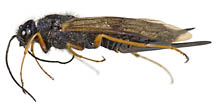Alien woodwasp that could threaten nation's pine trees found in Fulton, N.Y., by Cornell researcher

Despite dozens of interceptions at U.S. ports, a public enemy has infiltrated the nation's borders. Taken captive in Fulton, N.Y., and identified by a Cornell University expert, the adult female alien is the only one of its kind ever discovered in the eastern United States.
The discovery of a single specimen of Sirex noctilio Fabricius, an Old World woodwasp, raises red flags across the nation because the invasive insect species has devastated up to 80 percent of pine trees in areas of New Zealand, Australia, South America and South Africa. If established in the United States, it would threaten pines coast-to-coast, particularly in the pine-dense states in the Southeast. One target would be loblolly pines in Georgia.
Finding one bug in a trap is no small matter. Where there's one, there's likely to be more, says E. Richard Hoebeke, a Cornell senior extension associate in entomology. "Whenever you find an insect in a trap, it probably is established."
Hoebeke was sifting through thousands of bark beetles caught in routine screening traps set by the New York State Cooperative Agricultural Pest Survey (CAPS) program, in search of any of 10 exotic species of bark beetles, when he stumbled across the specimen of S. noctilio.
"I recognized it immediately," says Hoebeke, a taxonomic expert who has examined tens of thousands of insects sent to him from agencies and scholars over the past 25 years. "I'm always on the lookout for exotics -- for any species that are not yet established in the United States and known to be potential pests."
He published a report on his discovery in a recent issue of the Newsletter of the Michigan Entomological Society (50: 24-25, 2005).
Both federal and state regulatory agencies currently are carrying out a large dragnet, setting multiple traps in places they suspect the woodwasp may be doing its destructive work. The effort is widespread because, Hoebeke says, "The potential damage from this exotic woodwasp could be monumental."
Since 1985 U.S. Department of Agriculture Animal and Plant Health Inspection Service inspectors have intercepted seven male S. noctilio at various borders; all had come with tile and marble imports from Spain and Italy. In addition, one female was found in a warehouse in Indiana in 2002. Experts suspect that the female alien that was trapped in Fulton probably hitchhiked into the area on a wooden crate or in packing material.
The woodwasp, which is native to Europe, Asia and northern Africa, where it rarely is a pest, kills pines, and sometimes several other types of conifers, by introducing a toxic mucus and spores of a toxic fungus when the female lays her eggs through the bark and into the sapwood of the tree.
"If S. noctilio is found to be established in New York or elsewhere in the U.S., we could launch a rapid response to contain and control the infestation," says Hoebeke. A biological control method using a parasitic nematode has been remarkably effective in other countries in the southern hemisphere where the woodwasp has been accidentally introduced, he says.
Media Contact
Get Cornell news delivered right to your inbox.
Subscribe